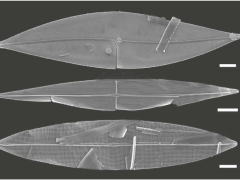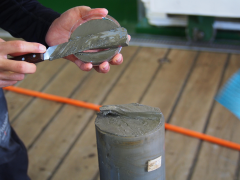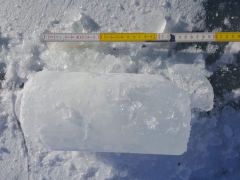
Home run for the RV Maria S. Merian:
Research vessel sets off towards the Baltic Sea ice
for the "Deep Baltic" mission
11.03.2021 – Biomarkers: contemporary witnesses of past climates
Biomarkers could be described as chemical fossils. They are chemical compounds, which are stable in (ocean) sediments over thousands to millions of year, even though the organisms that produced them are long rotten. Biomarkers found in marine sediments can be associated with very specific organisms and are used by scientists to reconstruct water temperature. Others provide information on the sea ice extent.
One biomarker the scientists of MSM 99 Deep Baltic are especially interested in, is called IP25 (Ice Proxy with 25 Carbon Atoms), it is exclusively produced by specific algae, more precisely diatoms (Fig 1). These diatoms live only in the capillaries at the underside of sea ice, which is filled with hyper saline water. When the sea ice melts, the ice algae and the included biomarkers are deposited at the sea floor. So far, IP25 is the only direct method to reconstruct past sea ice changes.
During expedition MSM99 Deep Baltic scientists from the Institute of Geosciences in Kiel collect sea ice and sediment samples to reconstruct changes in the sea ice cover of the Baltic Sea (Fig 2). The collected sea ice and sediment cores, will be transported frozen or cooled to Kiel. There, the actual work starts with the chemical processing of the samples to analyze the biomarker content with a mass spectrometer and/or gas chromatograph.
So far, there are only very few studies on the sea ice biomarker IP25 from the Baltic Sea. In order to investigate if the IP25 method is applicable in the Baltic Sea, first we will analyze the ice cores, to confirm the presence of the producers of IP25 in Baltic Sea sea ice. Due to the low salinities in the Baltic Sea it is questionable if the diatoms, producing IP25, are present. If we find them, it will be possible to reconstruct changes in sea ice cover of the past Baltic Sea.
These reconstructions are especially important to get a better understanding of the climate changes in the Baltic Sea. Past expeditions with Maria S. Merian to the Baltic Sea (MSM51 and MSM62) brought up the hypothesis that during cold periods, deep water formation and the oxygenation of the deeper water layers is enhanced while this process is reduced during warmer climate phases (Moros et al., 2020). Especially in regard to the expected ongoing climate warming it is crucial to gain a better understanding of the interconnection. Exact sea ice reconstructions will help to validate the hypothesis of Moros et al. (2020) and may help to increase the accuracy of future predictions.
References:
Brown, T. A., Belt, S. T., Tatarek, A., & Mundy, C. J. (2014). Source identification of the Arctic sea ice proxy IP 25. Nature Communications, 5(1), 1-7.
Moros, M., Kotilainen, A. T., Snowball, I., Neumann, T., Perner, K., Meier, H. M., ... & Schneider, R. (2020). Is ‘deep-water formation’in the Baltic Sea a key to understanding seabed dynamics and ventilation changes over the past 7,000 years?. Quaternary International, 550, 55-65.
Text and photos by Henriette Kolling (CAU) | click photos to enlarge
| Expedition: | MSM99 |
| Mission: | Deep Baltic |
| Start: | 25.02.2021 - Emden |
| Destination: | 23.03.2021 - Emden |
Maria S. Merian: current position


